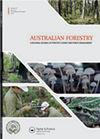巴西尾巨桉人工林对除草条的长期生长响应
IF 0.9
4区 农林科学
Q3 FORESTRY
引用次数: 0
摘要
摘要:一些研究已经报道了杂草竞争对桉树人工林的影响,但大多数研究都集中在初始生长上。本文报道的研究目的是评估乌兰桉在不同宽度的杂草控制带中的长期生长反应及其在七年内轮作区的竞争表现。在巴西巴伊亚州Eunápolis的商业区(12960平方米)进行了一项实验。处理包括在作物种植的前六个月保持的桉树种植线两侧具有以下宽度的杂草控制带:0厘米(杂草检查控制);25厘米;50厘米;75厘米;100厘米;125厘米;150厘米;175厘米;和200厘米(无杂草对照)。125cm的杂草控制带在7年后获得了最佳的桉树生长性能,与杂草对照相比增长了61.8%。E.urorandis的竞争力指数在种植的头两年后趋于上升,这是杂草干扰最严重的时期。本文章由计算机程序翻译,如有差异,请以英文原文为准。
Long-term growth response to weed-control strips in Eucalyptus urograndis plantations in Brazil
ABSTRACT Several studies have reported the effect of weed competition on eucalypt plantations, but most have focused on initial growth. The aim of the study reported here was to evaluate the long-term growth response of Eucalyptus urograndis in weed-control strips of different widths and its competitive performance in a rotation area over seven years. An experiment was conducted in a commercial area (12 960 m2) in Eunápolis, Bahia, Brazil. The treatments consisted of weed-control strips with the following widths on both sides of eucalypt planting lines maintained for the first six months of crop cultivation: 0 cm (weedy check control); 25 cm; 50 cm; 75 cm; 100 cm; 125 cm; 150 cm; 175 cm; and 200 cm (weed-free control). The 125-cm weed-control strip obtained the best eucalypt growth performance after seven years, with a gain of 61.8% compared with the weedy check control. The competitiveness index of E. urograndis tended to increase after the first two years of cultivation, the period in which the interference caused by weeds was most accentuated.
求助全文
通过发布文献求助,成功后即可免费获取论文全文。
去求助
来源期刊

Australian Forestry
FORESTRY-
CiteScore
3.70
自引率
4.80%
发文量
15
审稿时长
>12 weeks
期刊介绍:
Australian Forestry is published by Taylor & Francis for the Institute of Foresters of Australia (IFA) for scientific, technical, and professional communication relating to forestry in the Asia Pacific.
 求助内容:
求助内容: 应助结果提醒方式:
应助结果提醒方式:


